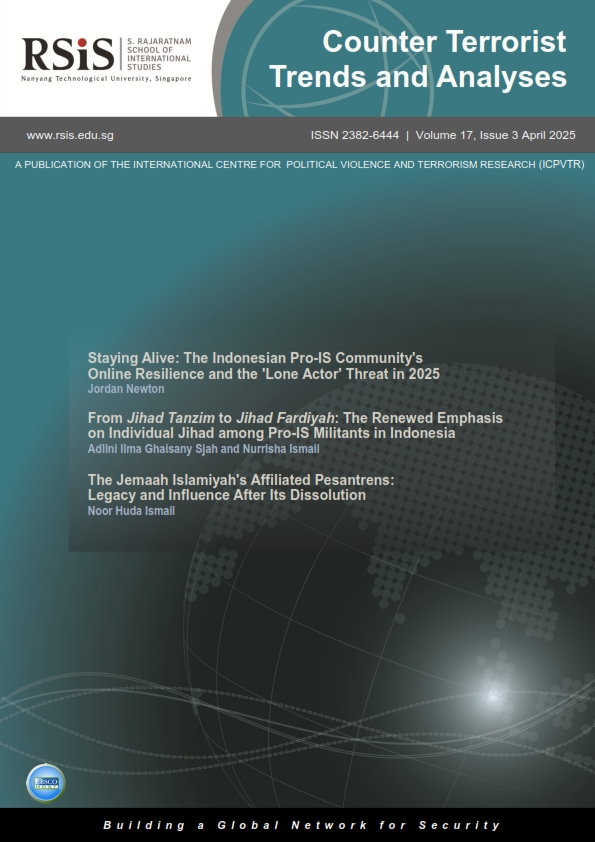21 April 2025
- RSIS
- Publication
- RSIS Publications
- Counter Terrorist Trends and Analyses (CTTA) – Volume 17 Issue 03
Editorial note: Weak but Persistent and Evolving Threat of Jihadist Militancy in Indonesia
In September 2024, Indonesia’s longstanding pro-Al-Qaeda jihadist group Jemaah Islamiyah (JI)’s decision to formally disband itself surprised everyone. It sparked an intense debate about whether the group has genuinely dissolved itself or made the move to avoid further counterterrorism pressure from Indonesian authorities. At the same time, the pro-Islamic State (IS) Jemaah Anshorut Daulah (JAD), a network of small cells, has also lost steam amidst its struggle to carry out large-scale attacks in recent years. As a result, the jihadist threat in Indonesia has declined significantly with three key characteristics.
First, despite JI’s disbandment, its ideological influence continues to inspire self-radicalised individuals and lone-actor terrorists in Indonesia. JI is maintaining its influence through its widespread and well-entrenched network of charities and pesantrens. Likewise, the JAD’s ideology remains potent in online spaces and serves as a catalyst for aspiring pro-IS cells and individuals to act violently.
Second, as jihadist groups have weakened, a shift from organised to individual “jihad” has become prominent. As Indonesian jihadist groups have struggled to maintain offline presence due to strong counterterrorism policing in Indonesia, online radicalisation has gained traction among would-be Indonesian radicals. Likewise, since plotting and executing coordinated and large-scale attacks has become difficult, lone-actor terrorism has been the defining characteristic of the existing Indonesian threat landscape.
Third, the use of emerging technologies like cryptocurrency, generative AI and digital marketplaces is very limited among Indonesian jihadists; they make individual terror plots more significant from a future perspective. As these technologies will become more pervasive and user-friendly in the future, they will provide a competitive edge to Indonesian jihadists passing through a testing period currently. Against this backdrop, the current issue has featured three articles examining Indonesia’s pro-IS online community, the influence of jihadist doctrines on the country’s threat landscape from organised to individual “jihad”, and the effect of JI’s dissolution on pesantrens.
In the first article, Jordan Newton notes that Indonesia’s pro-IS online community, though somewhat diminished, continues to adapt, fuelling the emergence of new terrorist plots. Despite counterterrorism efforts, IS supporters have re-established themselves on mainstream social media platforms like Facebook, embedding their narratives within broader local, national, and international discourses. This evolving online presence, combined with the increasing use of technologies such as cryptocurrencies, digital marketplaces, and generative AI, is likely to facilitate the rise of self-radicalised or inspired individuals in the future. Furthermore, the author maintains that as these extremist online networks persist and adapt, counterterrorism authorities face the challenge of addressing this threat while navigating budget constraints and competing priorities in the years ahead.
In the second article, Adlini Ilma Ghaisany Sjah and Nurrisha Ismail explore the influence of jihadist doctrines on the terrorism threat landscape in Indonesia. In recent years, new small-scale pro-IS cells have continued to emerge in Indonesia, a noticeable shift from the large-scale networks of pro-IS operations in the past. This shift can be attributed to a renewed emphasis on the doctrine of jihad fardiyah (individual jihad), in contrast to jihad tanzim (organised jihad) which prioritises organisation-building. By examining both doctrines, the authors present a clearer understanding of the goals of pro-IS groups in Indonesia and their potential future trajectory. In the future, the deliberate and persistent use of jihad fardiyah will likely rise, particularly through a hybridised approach in the form of large pro-IS networks consisting of small and insulated cells.
In the last article, Noor Huda Ismail examines the effect of the dissolution of JI on Islamic boarding schools, otherwise known as pesantrens, affiliated with JI. While JI rarely owned or directly funded pesantrens, the strategic placement of the JI members as pesantren teachers allowed the group to exert ideological influence on the wider community, connected it to a support base for potential recruitment and facilitated chosen students for “global jihad.” Despite JI’s formal dissolution, its ideological influence among segments of Indonesian society is likely to endure, particularly through the vast network of the Forum Komunikasi Pondok Pesantren (FKPP). The author argues that there is a need to reform JI-affiliated teaching systems – including fostering critical thinking skills and prioritising values of inclusivity and respect for diversity – to disrupt the cycle of radical indoctrination.
HTML Article Versions
Editorial note: Weak but Persistent and Evolving Threat of Jihadist Militancy in Indonesia
In September 2024, Indonesia’s longstanding pro-Al-Qaeda jihadist group Jemaah Islamiyah (JI)’s decision to formally disband itself surprised everyone. It sparked an intense debate about whether the group has genuinely dissolved itself or made the move to avoid further counterterrorism pressure from Indonesian authorities. At the same time, the pro-Islamic State (IS) Jemaah Anshorut Daulah (JAD), a network of small cells, has also lost steam amidst its struggle to carry out large-scale attacks in recent years. As a result, the jihadist threat in Indonesia has declined significantly with three key characteristics.
First, despite JI’s disbandment, its ideological influence continues to inspire self-radicalised individuals and lone-actor terrorists in Indonesia. JI is maintaining its influence through its widespread and well-entrenched network of charities and pesantrens. Likewise, the JAD’s ideology remains potent in online spaces and serves as a catalyst for aspiring pro-IS cells and individuals to act violently.
Second, as jihadist groups have weakened, a shift from organised to individual “jihad” has become prominent. As Indonesian jihadist groups have struggled to maintain offline presence due to strong counterterrorism policing in Indonesia, online radicalisation has gained traction among would-be Indonesian radicals. Likewise, since plotting and executing coordinated and large-scale attacks has become difficult, lone-actor terrorism has been the defining characteristic of the existing Indonesian threat landscape.
Third, the use of emerging technologies like cryptocurrency, generative AI and digital marketplaces is very limited among Indonesian jihadists; they make individual terror plots more significant from a future perspective. As these technologies will become more pervasive and user-friendly in the future, they will provide a competitive edge to Indonesian jihadists passing through a testing period currently. Against this backdrop, the current issue has featured three articles examining Indonesia’s pro-IS online community, the influence of jihadist doctrines on the country’s threat landscape from organised to individual “jihad”, and the effect of JI’s dissolution on pesantrens.
In the first article, Jordan Newton notes that Indonesia’s pro-IS online community, though somewhat diminished, continues to adapt, fuelling the emergence of new terrorist plots. Despite counterterrorism efforts, IS supporters have re-established themselves on mainstream social media platforms like Facebook, embedding their narratives within broader local, national, and international discourses. This evolving online presence, combined with the increasing use of technologies such as cryptocurrencies, digital marketplaces, and generative AI, is likely to facilitate the rise of self-radicalised or inspired individuals in the future. Furthermore, the author maintains that as these extremist online networks persist and adapt, counterterrorism authorities face the challenge of addressing this threat while navigating budget constraints and competing priorities in the years ahead.
In the second article, Adlini Ilma Ghaisany Sjah and Nurrisha Ismail explore the influence of jihadist doctrines on the terrorism threat landscape in Indonesia. In recent years, new small-scale pro-IS cells have continued to emerge in Indonesia, a noticeable shift from the large-scale networks of pro-IS operations in the past. This shift can be attributed to a renewed emphasis on the doctrine of jihad fardiyah (individual jihad), in contrast to jihad tanzim (organised jihad) which prioritises organisation-building. By examining both doctrines, the authors present a clearer understanding of the goals of pro-IS groups in Indonesia and their potential future trajectory. In the future, the deliberate and persistent use of jihad fardiyah will likely rise, particularly through a hybridised approach in the form of large pro-IS networks consisting of small and insulated cells.
In the last article, Noor Huda Ismail examines the effect of the dissolution of JI on Islamic boarding schools, otherwise known as pesantrens, affiliated with JI. While JI rarely owned or directly funded pesantrens, the strategic placement of the JI members as pesantren teachers allowed the group to exert ideological influence on the wider community, connected it to a support base for potential recruitment and facilitated chosen students for “global jihad.” Despite JI’s formal dissolution, its ideological influence among segments of Indonesian society is likely to endure, particularly through the vast network of the Forum Komunikasi Pondok Pesantren (FKPP). The author argues that there is a need to reform JI-affiliated teaching systems – including fostering critical thinking skills and prioritising values of inclusivity and respect for diversity – to disrupt the cycle of radical indoctrination.
HTML Article Versions





